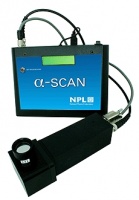Its development was inspired by the events following the murder of Alexander Litvinenko in London in 2006.
Litvinenko was killed by radiation poisoning from polonium-210, which emits tissue-damaging alpha particles.
It prompted wide-scale work to assess radiation levels at almost 50 premises in London where he had been prior to his death before opening them up again to the public, costing the Health Protection Agency £2m.
Much of the effort relied on radiation detectors known as scintillation counters. These devices must be operated by skilled operators who are willing to scan surface areas from a distance no greater than 2cm, due to limited range of alpha particles and their tendency to be suppressed by surface moisture and roughness.
After years of development, NPL said that is has overcome those limitations with a new alpha detector prototype that does not seek out individual alpha particles.
Instead it spots the photons that are produced when alpha particles react with nitrogen in the atmosphere. These bursts of light, which are in the ultraviolet range, are invisible to the naked eye.

Dr Jessica Cheung, senior research scientist at NPL, said that the detector is so sensitive to light it would break down if exposed to normal sunlit conditions.
Therefore, the detectors must work in rooms lit by sodium lamps, which emit a wavelength out of the detectors’ range.
Dr Cheung said that one of the greatest achievements of the detector is its improved range. ‘We can operate it at 20cm away from the surface in laboratory conditions,’ she said.
NPL describes its prototype detector as a modular design. Its optical housing can be inserted with 1in optics for a variety of wavelengths.
The detector’s Labview controlled electronics are powered by a lithium ion battery, which provides up to eight hours of continuous usage.
Ray Chegwin, business development manager at NPL, said the team is currently in discussions with various contacts in the security and nuclear industries to further develop the product for commercialisation.











Water Sector Talent Exodus Could Cripple The Sector
Maybe if things are essential for the running of a country and we want to pay a fair price we should be running these utilities on a not for profit...